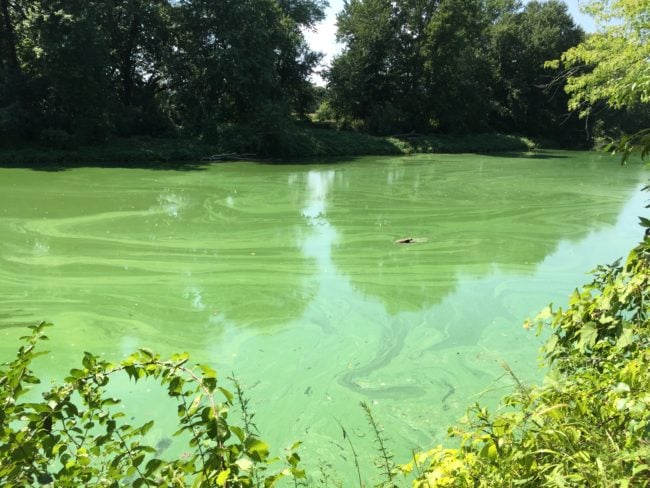It’s time to treat the source of harmful algal blooms – not just the symptoms

Wallkill River algae bloom (Photo: Emily Vail)
View more images on our Flickr site
In the fight against harmful algal blooms, New York is leaving a major tool of the Clean Water Act on the shelf: new water quality criteria for nutrients.
Excess nutrients are a root cause of most harmful algal blooms, and a host of other water quality problems, including the formation of disinfection byproducts in public drinking water supplies, and the degradation of habitat for aquatic life. Statewide in 2018, harmful algal blooms were observed in more than 170 waterbodies. In the Hudson 7 communities that rely on the Hudson River for drinking water, over $25 million in projects have been planned or built to upgrade drinking water treatment, primarily to reduce disinfection byproducts. In the Wallkill River, in addition to the formation of harmful algal blooms, excess nutrients are responsible for startling declines in the diversity of aquatic life. The examples go on.
New York has relied on an outdated narrative nutrient standard for too long, and it shows.
Water quality criteria are a bedrock component of the Clean Water Act. Numeric criteria would set clear standards for the amount of nutrients (phosphorus and nitrogen) and nutrient indicators (chlorophyll a and turbidity) that our waterways can tolerate. When a waterway exceeds those standards, we’d know that it’s time to treat the root causes of problems like harmful algal blooms, rather than wait for the symptoms to prompt action.
It has been over 20 years since the U.S. Environmental Protection Agency published a national strategy for modernizing nutrient criteria. It has been over 15 years since New York and other states were to have developed numeric criteria. And yet, both EPA and New York have continually moved the goalposts, with time frames extended and deadlines missed. That’s why Riverkeeper is issuing a white paper, “Algae, Weeds, and Slimes, Oh My: A Call for Numeric Nutrient Criteria in New York State,” calling on the State to propose numeric nutrient criteria this year.
A year ago, Governor Cuomo announced a series of plans to address harmful algal blooms in 12 priority locations, pledging to “do all that we can do to eradicate these blooms once and for all.”
In each of the 12 plans, the same sentences appear: “Although the causes of HABs vary from lake to lake, phosphorus pollution – from sources such as wastewater treatment plants, septic systems, and fertilizer runoff – is a major contributor. Other factors likely contributing to the uptick in HABs include higher temperatures, increased precipitation, and invasive species.”
In other words, the underlying conditions – excess phosphorus and ecosystem changes from invasive species – are exacerbated by changing weather patterns associated with climate change: warmer temperatures and more intense storms.
We can and should act immediately to reduce the risk of harmful algal blooms by reducing nutrient pollution. Adopting strong numeric nutrient criteria is an important step that New York must take to address the cause, and not just the symptoms, of excess nutrient pollution.
